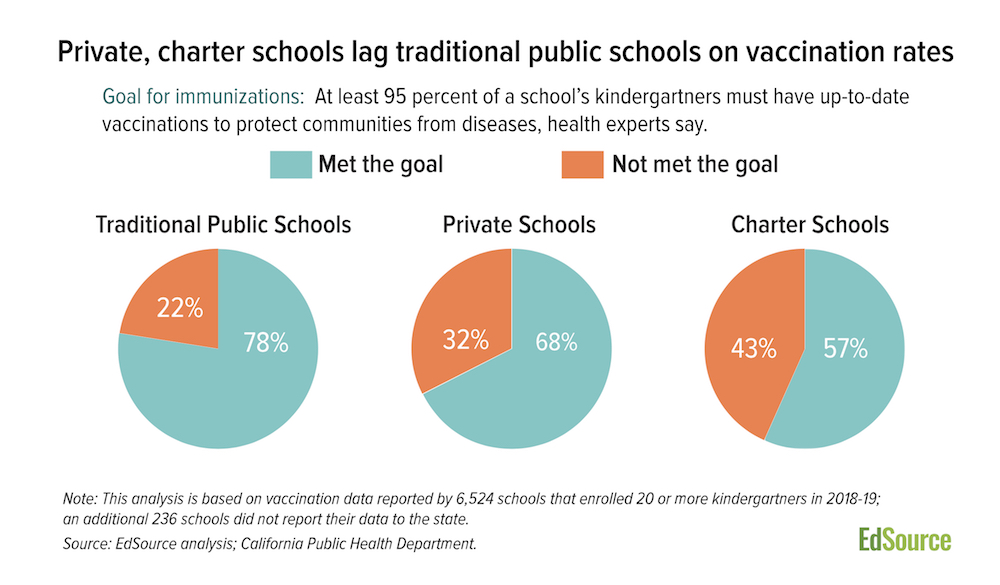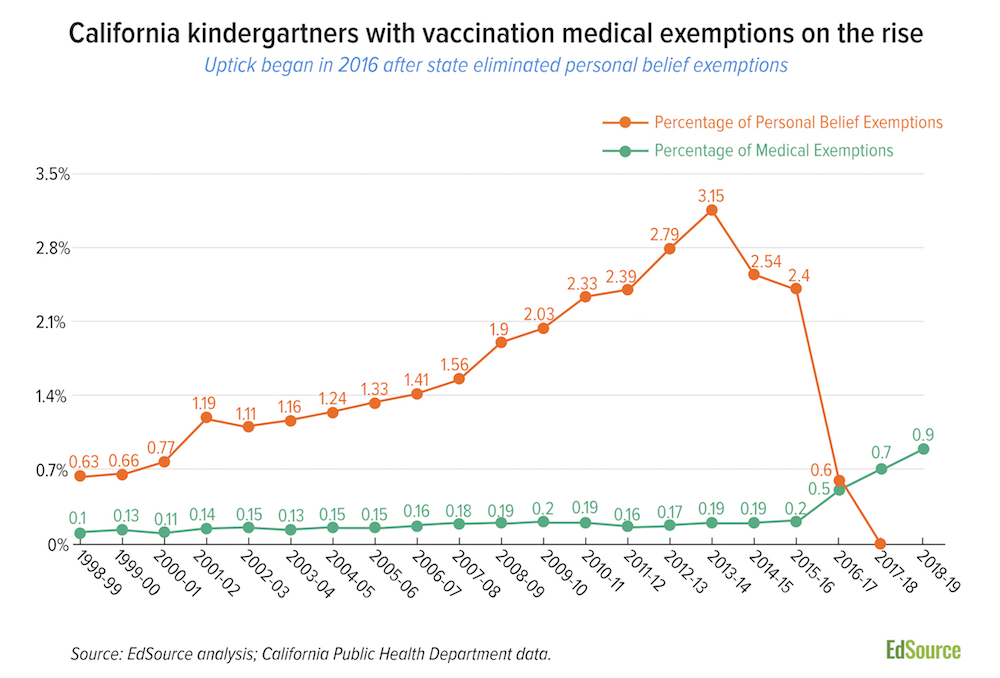
California’s charter and private schools dramatically lag traditional public schools in the percentage of students vaccinated for contagious diseases.
Last year, 78 percent of traditional public schools reported that its students had all required vaccinations necessary to protect the community, while only 68 percent of private schools and 57 percent of charter schools met that goal, an EdSource analysis of California Department of Public Health data reveals.

Ninety-five percent of children at a school must be immunized to prevent transmission of disease in a community, according to the state Department of Public Health.
At the same time, charter schools and private schools led the state in the percentage of students exempted from vaccinations for medical reasons. The uptick followed a 2016 law that banned the so-called personal belief exemption that allowed parents to opt their children out of vaccinations.
At the start of the 2018 school year, nearly 7 percent of charter school students were allowed to enroll because they had medical exemptions; in private schools almost 6 percent enrolled with medical exemptions. That compares to less than 1 percent of traditional public school students with medical exemptions.
“Like California’s traditional district schools, charter public schools are required to comply with the law,” said California Charter Schools Association spokeswoman Brittany Chord Parmley in a statement. “All public school students in classroom-based instructional programs must be vaccinated unless they have a medical exemption. The California Charter Schools Association provides information about these vaccination requirements to all California charter schools.”
Sen. Richard Pan, D-Sacramento, who authored the bill that eliminated the personal belief exemption, worries that schools with low vaccination rates could be “the tinder that starts the fire” and spreads disease throughout the state.
Under state law, children must be immunized against 10 serious communicable diseases if they want to attend public or private schools and child care centers. Studies have linked clusters of unvaccinated children to outbreaks of measles, pertussis and chicken pox.
Children who are not vaccinated can only attend school if they have a medical exemption, are homeless or are admitted conditionally while catching up on vaccinations. Students admitted conditionally must adhere to a vaccine schedule and not be due for any doses, while homeless students must receive all required immunizations as soon as possible after beginning school.
Medical exemptions, which have gone up fivefold since 2011, to 4,812, have poked holes in the state’s vaccination law — one of the strongest in the country. Families can get a medical exemption from a doctor who states that the child should not be vaccinated because of either a temporary or permanent medical condition.
Pan said his latest bill, Senate Bill 276, will reduce these pockets of low vaccination rates by regulating medical exemptions. He said schools with 10 percent or higher medical exemptions create pockets of unvaccinated students who undermine the state’s high vaccination rates.

Statewide, nearly 95 percent of all kindergarten students started school in 2018 with all the required vaccinations. That’s up 2 percent from three years earlier, but a slight dip — less than 1 percent — from the previous year.
“It’s not the overall vaccination rate across the state we should be most worried about,” Pan said. “We need to continue to protect those gains and we need to look at the pockets of low vaccination rates.”
The EdSource analysis includes an interactive map that shows the location and details of schools whose vaccination rates fall below 95 percent, the level needed to protect a community from an outbreak.
Interactive Data Map

This interactive map shows the location and details of California schools whose vaccination rates fall below 95 percent. If you want to search for a school by name, go to this lookup.
Those hot spots can be found north and east of San Francisco, in Sacramento and its surrounding suburbs and in the outskirts of Los Angeles. In the Sacramento area every school that has fewer than 81 percent of its students vaccinated is a charter school.
Schools with vaccination rates of less than 50 percent are largely charter schools in Sutter, Placer and Nevada counties in Northern California, with many offering online or independent study instruction. Some of these schools serve home-schooled students who by state law are exempt from vaccination.
The EdSource analysis focused on 6,524 public and private schools that enrolled at least 20 kindergarten students in the 2018-19 school year. Schools that fell below that enrollment were not included in the state’s data. All schools are required to report; 236 did not. The analysis shows:
- One in 4 California schools had low vaccination rates for kindergartners in 2018-19 school year.
- Most of the 63 schools with less than 50 percent of students vaccinated were charter and private schools: 47 were charters, 10 were private and six were traditional public schools. The private schools include five Waldorf schools whose approach to education is based on the philosophy of Austrian philosopher Rudolf Steiner.
- Among all schools, there are 20 with Waldorf in their name: five had vaccination rates under 50 percent and 11 had vaccination rates between 51 and 75 percent. Waldorf schools are usually independent private schools, but some, often called Waldorf-inspired schools, are public.
- Nearly three-fourths of all schools have at least one child receiving a medical exemption; 117 have at least 10 percent of its students exempted from vaccinations for medical reasons.

Communities can guard from disease outbreaks by having a sufficient portion of residents vaccinated. The concept, referred to as herd or community immunity, also protects newborns and those with chronic illness who can’t be vaccinated.
Of particular concern is measles. There have been 1,164 cases confirmedin 28 states in the U.S. between Jan. 1 and July 25 — the greatest number since 1992, according to the Centers for Disease Control and Prevention. There have been measles outbreaks — defined as three or more cases — in Butte, Los Angeles, Orange, Placer, Sacramento, San Mateo and Santa Clara counties this year.
Measles can be serious for children younger than age 5, adults older than age 20, or for people with compromised immune systems. Serious complications include pneumonia and encephalitis.
As of July 1, 2016, students who attend a home-based private school or an independent study program without classroom-based instruction do not require immunizations. But the students must be immunized if they attend classroom programs.
“This is not how charter schools are interpreting the law,” said Leah Russin, executive director of Vaccinate California, a vaccine advocacy group. She said some schools allow unvaccinated home-schooled students to attend their schools part of a week.
Medical exemptions have jumped the most in charter schools and private schools between 2015-16 and 2018-19: charter schools were up from less than 1 percent to 7 percent. Private schools increased from less than 1 percent to 6 percent; traditional public schools saw an uptick but remained less than 1 percent.
The state data does not say how many students with medical exemptions attended each school. But there were more kindergartners enrolled in charter and private schools where 10 percent or more of kindergarten students had medical exemptions: 2,681 in charter schools; 1,738 in private schools and 390 in traditional public schools.
Sebastopol Independent Charter, a K-8 school in Sonoma County with 293 students, had one of the lowest vaccination rates in the state for incoming kindergartners in 2018-19. Nearly 57 percent of the 44 incoming kindergartners at the public Waldorf school did not have all their required vaccinations. That’s an improvement over 2010-11 when the non-vaccinated rate was 88 percent.
At the same time, the school’s medical exemptions are up. No child at the school had a medical exemption in 2013, but a quarter of the school had exemptions by 2016 and nearly half by 2018.
Sebastopol Independent Charter Executive Director Chris Topham said the school complies with California’s vaccination laws and doesn’t offer parents advice about whether they should vaccinate their children.
“The vaccination rate is a result of the parents’ choice to pursue medical exemptions through a doctor and is not something coming from the school at all,” he said. “I just want to be clear. The school is not involved. It is something the parents have decided. Why they have decided this I don’t know.”
Students at the school come from Sebastopol, as well as nearby communities like Santa Rosa, Topham said.
Pan said Senate Bill 276 will reduce these pockets of low vaccination rates by cracking down on doctors who issue exemptions that are not medically justified.
It calls for the California Department of Public Health to review a medical exemption only if a child attended a school with an immunization rate of less than 95 percent, if the doctor who signed the exemption had written five or more during the year or if a school did not provide the department with its vaccination rates.
The bill, which is in the Assembly Appropriations Committee, should return to the Senate for consideration in September and, if passed, is expected to be signed by Gov. Gavin Newsom.
An indication of the need to regulate medical exemptions surfaced earlier this month in a report from Kaiser Health News that the Medical Board of California is currently investigating at least four doctors for allegedly issuing questionable medical exemptions to children whose parents were trying to avoid immunizations.
Two Sacramento doctors are being investigated for giving medical exemptions to pediatric patients that a medical board doctor said were questionable or without medical basis, the report said. Two doctors in Santa Rosa also are being investigated for giving questionable medical exemptions to pediatric patients. One is a psychiatrist who runs an anti-aging clinic.
The bill “will close down all the doctors that are validating parent fears,” Russin said. “My personal belief is that when parents can’t find any doctor in California (to write an exemption), that they will vaccinate. People will start protecting their kids.”
The anti-vaccination lobby sees it much differently.
“We can’t institute forced vaccination policy when we don’t know who is at risk (from vaccines),” said Barbara Loe Fisher, president of The National Vaccine Information Center in Sterling Virginia who calls the proposed bill a violation of human rights. “Vaccination risks aren’t being shared equally. Some of us are at greater risk and our lives should also be valued.”
The new bill “is violating physicians’ right to protect a child that they think is at risk,” she added.
She said that parents are going to do whatever they have to do to protect their children from vaccination injury, including homeschooling them. “People are distraught,” she said. “People have talked about moving out of the state. People have moved out of California.”
*The analysis excludes 236 schools that did not report vaccination data to the state.Source: EdSource analysis; California Public Health Department data